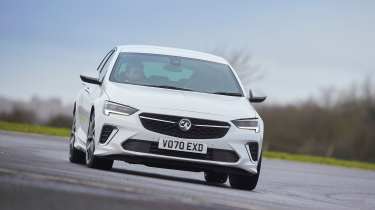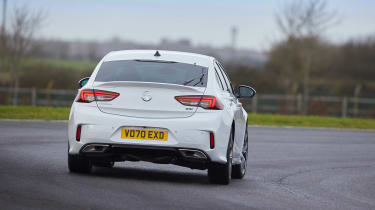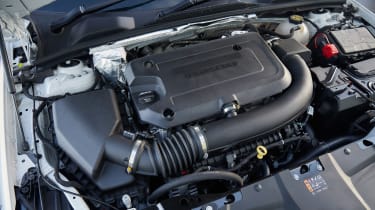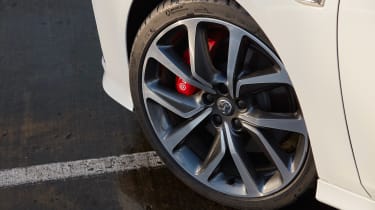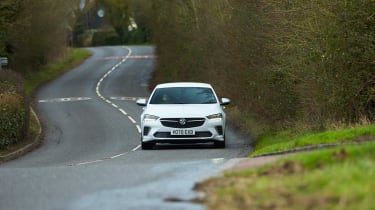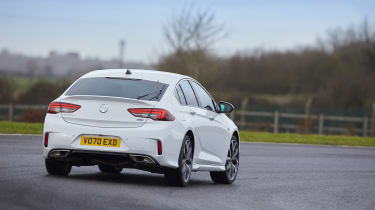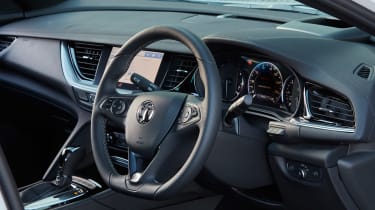Vauxhall Insignia GSi 2021 review – throwback family fun
Before Vauxhall benefits from Peugeot’s latest know-how, the Insignia soldiers to remind us of a time we have probably all forgotten
The Vauxhall Insignia is the most expensive development project ever undertaken by Vauxhall (i.e. Opel), even with inflation corrected. When the Insignia arrived in 2008 in large family sized saloon, hatchback and estate form it represented real investment in engineering for the brand.
Fast forward to 2021 and it’s largely the same Insignia still on sale, albeit with a change or two applied. Yet the ecosystem it operates within is totally different. Not only are the terms ‘SUV’ and ‘lifestyle’ considered bywords for today’s most popular models, but hybridisation and electrification are also very much on the agenda.
As a result the resolutely old-school Insignia, driven here in range-topping GSi specification, might feel somewhat out of step with what consumers currently want. This is something that arch rival Ford has already acknowledged by killing off the Mondeo next year, so does the Insignia’s package still hold enough inherent appeal to buck the trend?
Engine, transmission and 0-60 time
A performance derivative of the Insignia has been portrayed in a few different forms over its lifetime, and thanks to a recent update the GSi in its latest form features a 2-litre turbocharged four-cylinder petrol engine with 228bhp and 258lb ft of torque. The original GSi model that accompanied a wider redesign in 2017 was powered by a highly strung twin-turbocharged four-cylinder diesel, which has since been phased out. Performance is okay, the GSi reaching 62mph in 7.0sec. The engine is connected exclusively to a nine-speed automatic transmission and switchable all-wheel-drive system.
More reviews
Reviews
- Vauxhall Insignia GSi 2021 review – throwback family fun
- Vauxhall Insignia Grand Sport GSi BiTurbo review
- 2017 Vauxhall Insignia Grand Sport review
- Vauxhall Insignia VXR SuperSport review, price and specs
- Driven: Vauxhall Insignia 1.4T SRI
- Vauxhall Insignia 2.0i Turbo SRi 4x4 review
- Vauxhall Insignia VXR review
The chassis itself is of a certain vintage, as despite Vauxhall’s part in a new automotive conglomerate that includes everything from Peugeot to Jeep to Maserati, the Insignia’s platform and components are derived from its former GM connections, explaining its twins in China and America as the Buick Regal, and even Australia (briefly) as a continuation of the iconic Holden Commodore.
Technical highlights
From a technical point of view, there are a few performance-enhancing idiosyncrasies in the GSi, all of which were fine-tuned on the Nürburgring according to Vauxhall. These include adaptive dampers, chunky Brembo brakes, 20-inch wheels and a twin-clutch torque vectoring rear differential in a similar form to that found in the latest VW Golf R and Mercedes-AMG A45 S. Together with an extra 100bhp, it’s a spec that could almost read like that of a top-drawer hot hatchback. However, the reality is somewhat different.
To coincide with its placement at the top of the range, the GSi also comes with an array of convenience features including massaging, cooled and heated leather(ish) sports seats, adaptive LED headlights, a decent stereo and infotainment set-up and all the usual active safety gear. Vauxhall dropped the Insignia estate for the latest update too, making the five-door liftback the only bodystyle option.
What’s it like to drive?
The reason we mentioned the initial expense of the Insignia’s development is because it ultimately resulted in what is a very good chassis. The benefits of this core development work, without the contemporary must-haves of modularisation to suit a range of different models or the integration of electrification, can still be felt now.
The Insignia moves across the road with surprising fluency and naturalness. The steering is well weighted and accurate, if not brimming with feedback, and while the 20-inch wheels do have a tendency to crash into sharper road intrusions, overall body control and damping is good.
When in its default modes, the GSi has no qualms about tugging at the steering wheel under heavy throttle inputs, making its 228bhp feel about as much as you’d want to have going through the chassis – that is until you poke two little buttons on the centre console. Unusually, the all-wheel-drive system needs to be physically switched on in the GSi via one of said buttons, next to which also sits a Sport button, the latter usefully tightening both the steering and damping.
When selected the chassis feels even more capable, handling everything the powertrain can throw at it, but it also reveals the GSi’s Achilles heel. The powertrain is sluggish, unresponsive, strained at the top end and weak down low – elements that in normal driving don’t reveal themselves until you ask more of it. The automatic transmission is typical of many GM ’boxes, too, with an undefined feel to gearchanges that almost muddle into one CVT-like mess of flaring revs.
The rear differential doesn’t really make much of an impact as a result. There’s generally too little grunt actually being sent to the rear axle for torque vectoring to be of much use. Even the most brutish of inputs elicits a pretty flat return; instead the GSi will just grip and go (slowly). The GSi isn’t particularly efficient either, barely breaking 30mpg even when driven gently. Yet outright performance driving is not really the GSi’s core function. Calm things down, settle in for a bit of motorway cruising and the Insignia returns to its comfort zone.
Price and rivals
It’s fair to assume that most Insignias are purchased with some very solid on-paper justification, but for GSi buyers the heart might want to get involved. Priced at £38,125 the Insignia GSi does feel like a lot of car for the money in terms of outright sheet metal, but when compared to rivals its business case does start to break down.
Mainstream rivals like the Skoda Superb don’t have a traditional performance variant in the same sense as the GSi, but the £39,835 Sportline Plus does feature a 276bhp turbocharged 2-litre four-cylinder engine, dual-clutch gearbox and all-wheel drive. While it both lack the ultimate sophistication of the GSi on a challenging road, the powertrain is more efficient, flexible and refined.
The Volkswagen Passat and Peugeot 508 both feature hybridised powertrains at their upper levels with around the same power and torque as the Insignia, and both cost from around the £40k point. While neither could be considered dynamic to drive, they do use less than half the fuel, which when considered as a mile crusher is something to consider.
It really is crucial to understand that in isolation the Insignia GSi is still a good car, but the game has well and truly moved on. Ignoring for a moment that a mainstream family sized hatchback in 2021 might seem about as cool as white leather dress shoes, against fitter and faster rivals it really is a difficult car to recommend.

